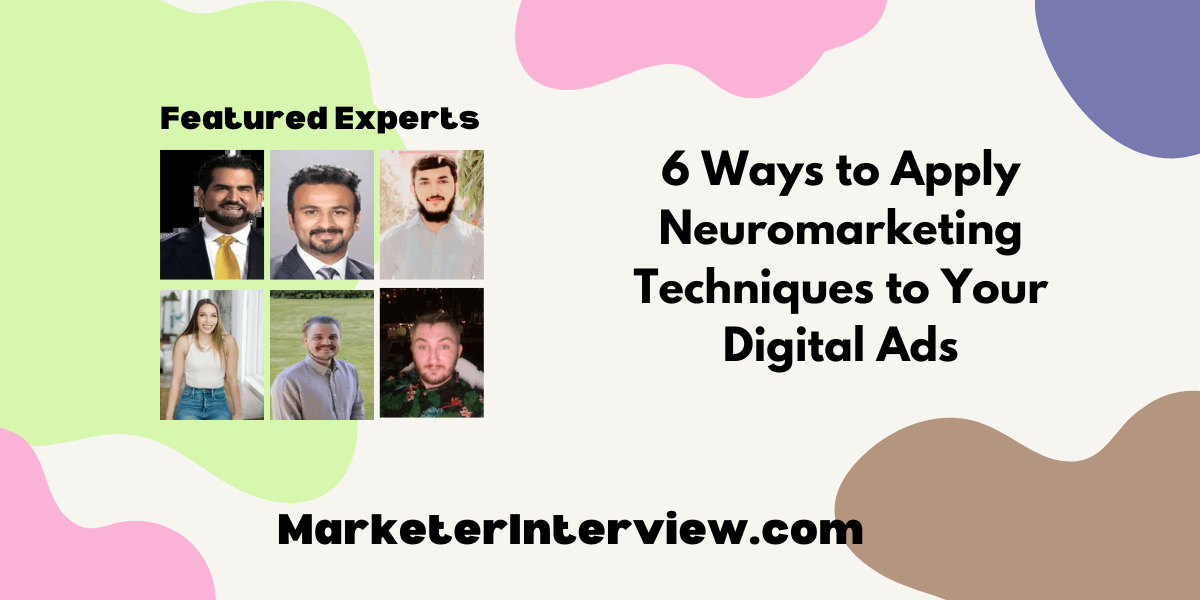6 Ways to Apply Neuromarketing Techniques to Your Digital Ads
Diving into the brainy side of advertising, we’ve gathered six neuromarketing experts to share their single most effective tip for enhancing digital ads. From utilizing emotional triggers to leveraging reciprocity with transparency, our contributors, including a co-founder and a digital marketer, offer insights that can transform your ad campaigns. Discover these cutting-edge strategies to captivate and convert your audience.
Want to get quoted in MarketerInterview.com content just like this? Apply to become a contributor today!
Contents
Utilize Emotional Triggers
I’ll go ahead and say that neuromarketing is required to some extent in every type of digital ad.
So, the one tip that I’d like to share is to use emotional triggers. I might sound a little harsh here, but the reality is that two things make people move in the world: money and emotions.
Therefore, by evoking certain emotions like nostalgia or FOMO, we can ensure the success of our ad campaign.
However, building up to this moment is crucial; otherwise, it will feel forced.
Also, a majority of marketers ignore it, but if you are going to use neuromarketing, look into research papers and case studies to gain a better understanding of your target audience.

Rahul Vij, Co Founder, WebSpero Solutions
Craft Ads With Emotional Resonance
One specific tip for applying neuromarketing techniques to your digital ads is to leverage the power of emotional triggers. Emotional triggers can significantly influence consumer behavior and decision-making, making your ads more engaging and effective.
- Happiness – Ads that evoke happiness through humor, positive imagery, or uplifting messages can create a strong connection with the audience, making them more likely to engage with the content.
- Fear of Missing Out (FOMO) – Highlighting scarcity or limited-time offers can trigger the fear of missing out, prompting quicker action from potential customers.
- Trust and Security – Demonstrating reliability, such as through testimonials or security assurances, can reduce consumer hesitation and build trust.
- Surprise and Novelty – Unexpected elements or novel ideas in your ads can capture attention and keep the audience intrigued.
Suppose you are promoting a new digital marketing service. To apply the emotional trigger of happiness, you might create an ad that showcases a successful business owner who used your service, smiling and celebrating their success. The ad could feature a tagline like, “Experience the joy of skyrocketing sales with our expert digital marketing services!”
Implementation:
- Visuals – Use bright, positive imagery that reflects the emotional trigger you’re aiming for. In the example above, include images of happy clients or success celebrations.
- Copywriting – Write copy that resonates emotionally. Use words and phrases that evoke the desired emotion. For happiness, use upbeat language and success stories.
- Call-to-Action (CTA) – Align your CTA with the emotional trigger. For happiness, a CTA like “Join the Success” or “Start Your Journey to Happiness” can be effective.
By tapping into emotions, your ads become more memorable and persuasive, leading to higher engagement rates and conversions. Emotional triggers can help break through the noise of digital advertising and create a lasting impact on your audience.
Incorporating emotional triggers into your digital ads is a powerful neuromarketing technique. By carefully crafting your visuals, copy, and CTAs to evoke specific emotions, you can enhance the effectiveness of your advertising campaigns and drive better results.

Arslan Abdul Rehman, Digital Marketer & SEO Expert, Siznam.co
Exploit the Frequency Illusion
I’m sure you’ve heard of color theory and the law of reciprocity, but my favorite neuromarketing technique is one that consistently increases conversions in our clients’ campaigns. It’s called the Baader-Meinhof Phenomenon, or Frequency Illusion.
Have you ever learned about something new and suddenly started seeing it everywhere? That’s the Baader-Meinhof Phenomenon in action. It’s not just coincidence; there’s a fascinating psychological principle behind it.
This phenomenon is driven by two key processes: selective attention and confirmation bias. When you encounter a new concept, your brain starts unconsciously looking for it, making you more likely to notice it (selective attention). Then, each time you spot it again, you feel a sense of confirmation, reinforcing its importance in your mind (confirmation bias).
In marketing, we leverage this phenomenon to boost brand awareness and conversions. By strategically using retargeting ads, we ensure that potential customers who’ve visited a client’s website continue to see the brand across various platforms. This repeated exposure makes the brand feel more familiar and trustworthy, significantly increasing the likelihood of conversion.
What’s particularly powerful about this technique is that it works subconsciously. Consumers aren’t aware of why they’re feeling more positively toward the brand; they just know that it feels more familiar and credible.
We’ve seen remarkable results using this approach. For instance, in one recent campaign, we increased conversion rates by 32% simply by optimizing our retargeting strategy based on the Baader-Meinhof Phenomenon.
It’s a prime example of how understanding human psychology can lead to more effective marketing strategies. By aligning our tactics with how the brain naturally processes information, we can create more impactful campaigns that resonate with audiences on a deeper level.

Michelle Merz, Marketing Consultant, Slantics
Highlight Scarcity and Human Faces
One neuromarketing technique I’ve used to boost digital ad performance is highlighting scarcity. Our brains are wired to perceive scarce resources as more valuable. For a flash sale campaign, we tested an ad that said “70% off, 24 hours only!” against one without a time constraint. The scarcity ad drove 65% higher click-through rates and 73% more sales.
I’ve also found that using faces in ads is very effective. Our brains are extremely attuned to human faces, so they grab our attention. For a client promoting an online course, an ad featuring the instructor’s smiling face generated 52% higher signups than one focused only on text and logos.
Finally, I frequently use loss aversion by highlighting what people stand to lose by not taking action. For example, an ad for a free trial of software that said “Don’t miss your chance to optimize your workflow for 30 days free!” performed 18% better than one focused only on the benefits. We want to avoid loss and regret, so messaging what people might miss out on motivates them to engage.

Jesse Nelson, Founder, Simpleman Digital Marketing
Apply Color Psychology
One effective neuromarketing technique for digital ads is to use color psychology. Different colors evoke different emotions and reactions. For example, blue can create a sense of trust and security, while red can stimulate urgency and excitement.
When designing your ads, choose colors that align with the emotional response you want to create in your audience. Test different color schemes to see which ones perform best. This approach taps into subconscious reactions, making your ads more compelling and effective in grabbing attention and driving action.

Daniel Bunn, Managing Director, Innovate
Leverage Reciprocity With Transparency
From a legal perspective, the application of neuromarketing techniques in digital advertising requires careful consideration of ethical and regulatory boundaries. One effective yet compliant approach is to leverage the principle of reciprocity, which taps into the brain’s inherent desire for fairness.
In practice, this could involve offering valuable content or a free trial before presenting your core offer. This strategy not only engages the consumer’s neural reward system but also builds trust, a crucial factor in decision-making. However, it’s imperative to ensure full transparency about the nature of the offer and any associated terms.
Implement clear opt-in mechanisms and provide easily accessible privacy policies to mitigate potential legal risks related to data collection and consumer protection regulations. This approach balances marketing effectiveness with legal compliance, fostering positive brand perception while minimizing legal exposure.

Alex Begum, Texas Personal Injury Lawyer, Villarreal & Begum, Texas Law Guns
Want to get quoted in MarketerInterview.com content just like this? Apply to become a contributor today!






